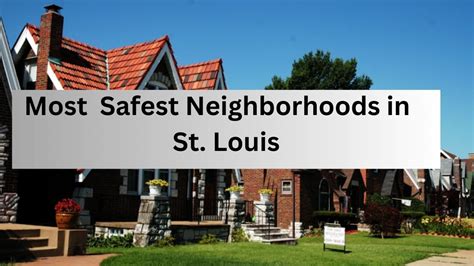St. Louis, Missouri, has consistently ranked among the most dangerous cities in the United States. According to the FBI’s Uniform Crime Reporting Program, the city’s violent crime rate was 1,886.5 per 100,000 people in 2020, more than twice the national average.

To ensure your safety while visiting or residing in St. Louis, it is crucial to be aware of the city’s most dangerous neighborhoods. This guide provides a comprehensive overview of the areas to avoid and offers practical safety tips to help you navigate the city with confidence.
Identifying the Most Dangerous Neighborhoods
The most dangerous neighborhoods in St. Louis are typically characterized by high rates of poverty, unemployment, and inadequate housing. These factors create a breeding ground for crime, including violent offenses such as murder, assault, and robbery.
According to data from the St. Louis Metropolitan Police Department, the following neighborhoods have consistently reported the highest crime rates in recent years:
| Neighborhood | Violent Crime Rate (per 1,000 residents) |
|---|---|
| JeffVanderLou | 22.9 |
| Wells-Goodfellow | 21.3 |
| Walnut Park East | 19.2 |
| Hamilton Heights | 18.9 |
| North Pointe | 18.7 |
Understanding the Causes of High Crime Rates
The high crime rates in St. Louis can be attributed to several interconnected factors, including:
- Poverty: Over 20% of St. Louis residents live below the poverty line, creating economic disparities and desperation that often lead to criminal activity.
- Unemployment: The city’s unemployment rate is consistently above the national average, leaving many residents without the resources to support themselves and their families.
- Inadequate Housing: Many neighborhoods in St. Louis are plagued by dilapidated housing, overcrowding, and a lack of essential amenities, which can contribute to crime and social unrest.
- Gang Activity: Gangs have a significant presence in St. Louis, fueling violent activity and drug trafficking.
- Historical Redlining: The practice of denying mortgages and insurance to Black families in certain neighborhoods, known as redlining, has resulted in persistent racial segregation and economic inequality, which are both linked to increased crime rates.
Safety Tips for Navigating St. Louis
While avoiding the most dangerous neighborhoods is the best way to minimize your risk of crime, it is also important to follow these safety tips when exploring the city:
- Be aware of your surroundings: Pay attention to the people and activities around you, and trust your instincts if you feel uncomfortable.
- Stay in well-lit, populated areas: Avoid walking alone at night or in isolated places.
- Be cautious with your belongings: Keep valuables hidden and avoid carrying large amounts of cash.
- Lock your car and valuables: Always lock your car doors and windows, and never leave valuables in plain sight.
- Report suspicious activity: If you witness anything suspicious, such as loitering or break-ins, report it to the police immediately.
Neighborhoods to Consider for Relocation
If you are considering relocating to St. Louis, it is important to research the city’s neighborhoods thoroughly. The following areas are generally considered safe and offer a variety of amenities:
- Clayton
- Central West End
- Dogtown
- Forest Park Southeast
- Shaw
Conclusion
Understanding the most dangerous neighborhoods in St. Louis is essential for ensuring your safety while navigating the city. By avoiding high-crime areas and following the safety tips outlined in this guide, you can minimize your risk of becoming a victim of crime.
While St. Louis faces significant challenges related to crime, it is important to remember that the city is also home to vibrant communities, cultural attractions, and historic landmarks. By working together to address the root causes of crime and invest in our neighborhoods, we can create a safer and more equitable future for all St. Louisans.
